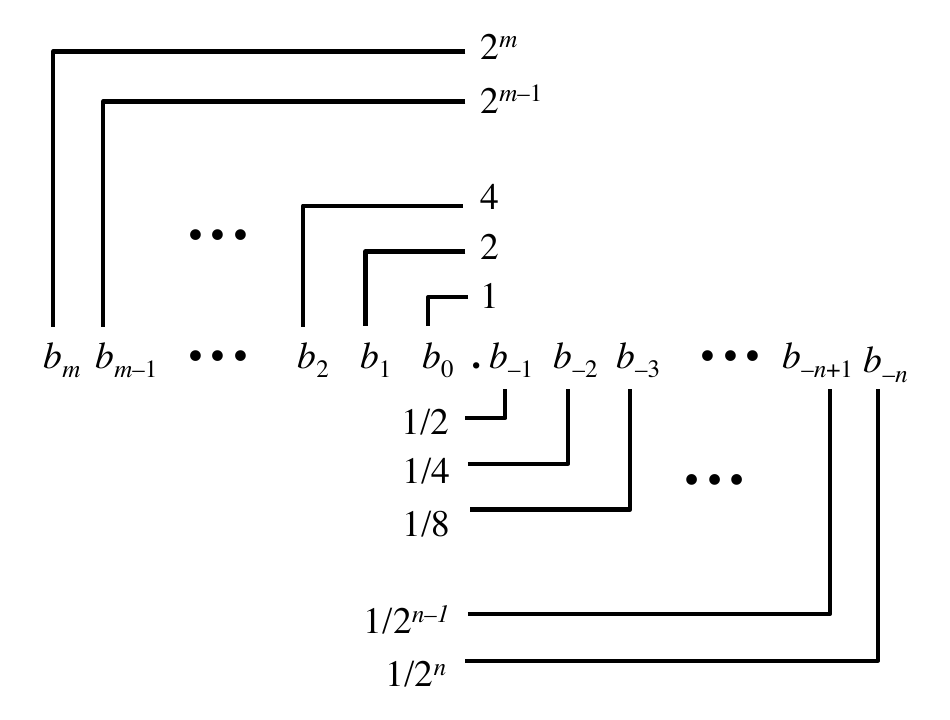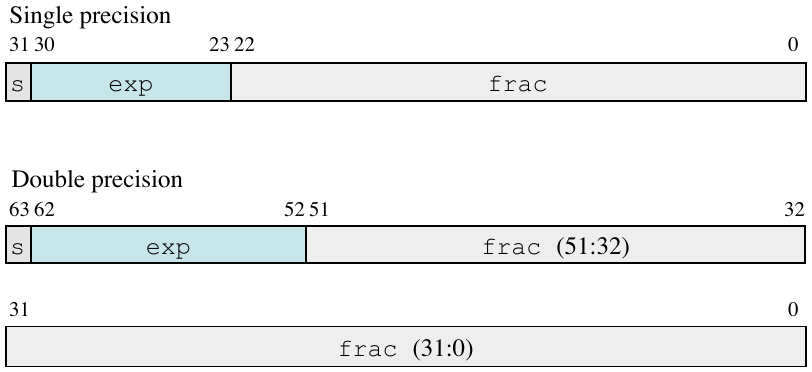Floating Point
CSC 235 - Computer Organization
References
- Slides adapted from CMU
Outline
Background: fractional binary numbers
IEEE floating point standard
Example and properties
Rounding, addition, and multiplication
Floating point in C
Summary
Fractional Binary Numbers
Representation
Bits to the right of “binary point” represent fractional powers of 2
Represents rational number: \(\sum_{k=-j}^{i} b_k \cdot 2^{k}\)
![Fractional Binary]()
Fractional Binary
Fractional Binary Number Examples
| Value | Representation |
|---|---|
| 23/4 | 101.11 = 4 + 1 + 1/2 + 1/4 |
| 23/8 | 10.111 = 2 + 1/2 + 1/4 + 1/8 |
| 23/16 | 1.0111 = 1 + 1/4 + 1/8 + 1/16 |
Observations
Divide by 2 by shifting right (unsigned)
Multiply by 2 by shifting left
Numbers of form \(0.1111 \ldots_{2}\) are just below 1.0
Representable Numbers
Limitation 1
Can only exactly represent numbers of the form \(\frac{x}{2^k}\)
- Other rational numbers have repeating bit representations
Example
- 1/3 = 0.01010101[01] \(\ldots_{2}\)
Limitation 2
Just one setting of binary point within the \(w\) bits
- limited range of numbers
IEEE Floating Point
IEEE Standard 754
Established in 1985 as uniform standard for floating point arithmetic
Supported by all major CPUs
Driven by numerical concerns
Nice standards for rounding, overflow, underflow
Difficult to make fast in hardware
Floating Point Representation
Numerical Form: \((-1)^s \cdot M \cdot 2^E\)
sign bit \(s\) determines whether number is negative or positive
significand \(M\) normally a fractional value in range \([1.0, 2.0)\)
exponent \(E\) weights value by power of two
Encoding:
most significant bit is sign bit \(s\)
exp field encodes \(E\) (but is not equal to \(E\))
frac field encodes \(M\) (but is not equal to \(M\))
Precision options
Single precision: 32 bits
exp field is 8 bits
frac field is 23 bits
Double precision: 64 bits
exp field is 11 bits
frac field is 52 bits
![Floating Point Precision]()
Floating Point Precision
Floating Point Numbers
Three different “kinds” of floating point numbers based on the exp field:
- normalized: exp bits are not all ones and not all zeros
- denormalized: exp bits are all zero
- special: exp bits are all one
Normalized Values
Exponent coded as a biased value: \(E = exp - bias\)
\(exp\): unsigned value of exp field
\(bias = 2^{k-1} -1\), where \(k\) is number of exponent bits
Significand coded with implied leading 1: \(M = 1.xx \ldots x_2\)
\(xxx \ldots x\): bits of frac field
minimum when \(frac = 000 \ldots 0\) (\(M = 1.0\))
maximum when \(frac = 111 \ldots 1\) (\(M = 2.0 - \epsilon\))
get extra leading bit for “free”
Normalized Encoding Example
Value:
float F = 15213.0;- \(15213_{10} = 11101101101101_{2} = 1.1101101101101_{2} \times 2^{13}\)
Significand
\(M = 1.1101101101101\)
\(frac = 11011011011010000000000\)
Exponent
\(E = 13\)
\(bias = 127\)
\(exp = 140 = 10001100_{2}\)
Denormalized Values
Exponent value: \(E = 1 - bias\) (instead of \(exp - bias\))
Significand coded with implied leading 0: \(M = 0.xxx \ldots x_{2}\)
- \(xxx \ldots x\): bits of frac
Cases
\(exp = 000 \ldots 0, frac = 000 \ldots 0\)
represents zero value
Note distinct values: \(+0\) and \(-0\)
\(exp = 000 \ldots 0, frac \neq 000 \ldots 0\)
numbers closest to 0.0
equally spaced
Special Values
Case: \(exp = 111 \ldots 1, frac = 000 \ldots 0\)
represents value \(\infty\) (infinity)
operation that overflows
both positive and negative
examples: 1.0/0.0 = -1.0/-0.0 = \(+\infty\), 1.0/-0.0 = \(-\infty\)
Case: \(exp = 111 \ldots 1, frac \neq 000 \ldots 0\)
Not-a-Number (NaN)
represents case when no numeric value can be determined
examples: sqrt(-1), \(\infty = \infty\), \(\infty \times 0\)
C float Decoding Example 1
floatvalue =0xC0A00000binary: 1100 0000 1010 0000 0000 0000 0000 0000
\(E = exp - bias = 129 - 127 = 2_{10}\)
\(s = 1\) negative number
\(M = 1.010 0000 0000 0000 0000 0000 = 1 + 1/4 = 1.25_{10}\)
\(v = (-1)^s \cdot M \cdot 2^E = (-1)^1 \cdot 1.25 \cdot 2^2 = -5_{10}\)
C float Decoding Example 2
floatvalue =0x001C0000binary: 0000 0000 0001 1100 0000 0000 0000 0000
\(E = exp - bias = 1 - 127 = -126_{10}\)
\(s = 0\) positive number
\(M = 0.001 1100 0000 0000 0000 0000 = 1/8 + 1/16 + 1/32 = 7 \cdot 2^{-5}\)
\(v = (-1)^s \cdot M \cdot 2^E = (-1)^0 \cdot 7 \cdot 2^{-5} \cdot 2^{-126} = 7 \cdot 2^{-131}\)
Tiny Floating Point Example
8-bit floating point representation
the sign bit is the most significant bit
the next four bits are the \(exp\), with a bias of 7
the last three bits are the \(frac\)
Same general form as IEEE format
normalized, denormalized
representation of 0, NaN, infinity
Dynamic Range (\(s = 0\))
| s | exp | frac | E | value | |
|---|---|---|---|---|---|
| 0 | 0000 | 000 | -6 | 0 | |
| closest to zero | 0 | 0000 | 001 | -6 | 1/512 |
| largest denorm | 0 | 0000 | 111 | -6 | 7/512 |
| smallest norm | 0 | 0001 | 000 | -6 | 8/512 |
| closest to 1 below | 0 | 0110 | 111 | -1 | 15/16 |
| 0 | 0111 | 000 | 0 | 1 | |
| closest to 1 above | 0 | 0111 | 001 | 0 | 9/8 |
| largest norm | 0 | 1110 | 111 | 7 | 240 |
| 0 | 1111 | 000 | - | inf |
Special Properties of the IEEE Encoding
Floating point zero same as integer zero
Can (almost) use unsigned integer comparison
must first compare sign bits
must consider -0 = 0
NaNs are problematic
Otherwise OK
Denormalized vs. normalized
Normalized vs. infinity
Floating Point Operations: Basic Idea
\(x +_{f} y = round(x + y)\)
\(x \times_{f} y = round(x \times y)\)
Basic idea
first compute exact result
make it fit into the desired precision
possibly overflow if exponent is too large
possibly round to fit into \(frac\)
Rounding
Rounding modes (illustrate with rounding USD)
$1.40 $1.60 $1.50 $2.50 -$1.50 towards zero $1 $1 $1 $2 -$1 round down (\(-\infty\)) $1 $1 $1 $2 -$2 round up (\(\infty\)) $2 $2 $2 $3 -$1 nearest even $1 $2 $2 $2 -$2 Nearest even rounds to the nearest, but if half-way in-between then round to nearest even
Closer Look at Round-To-Even
Default Rounding Mode
Difficult to get any other kind without dropping into assembly
All others are statistically biased
- sum of set of positive numbers will consistently be over- or under- estimated
Applying to other decimal places / bit positions
when exactly halfway between two possible values, round so that least significant digit is even
Example round to the nearest hundreth
7.8950000 = 7.90 (halfway – round up)
7.8850000 = 7.88 (halfway – round down)
Rounding Binary Numbers
Binary Fractional Numbers
“even” when least significant bit is 0
“half way” when bits to right of rounding position \(= 100 \ldots_{2}\)
Examples: round to the nearest 1/4 (2 bits right of binary point)
value binary rounded action rounded value \(2 \frac{3}{32}\) 10.00011 10.00 down \(2\) \(2 \frac{3}{16}\) 10.00110 10.01 up \(2 \frac{1}{4}\) \(2 \frac{7}{8}\) 10.11100 11.00 up \(3\) \(2 \frac{5}{8}\) 10.10100 10.10 down \(2 \frac{1}{2}\)
Rounding
Terminology
guard bit: least significant bit of result
round bit: the first bit removed
sticky bit: OR of remaining bits
Round up conditions
round = 1, sticky = 1 \(\rightarrow > 0.5\)
guard = 1, round = 1, sticky = 0 \(\rightarrow\) round to even
Rounding Example
Round to three bits after the binary point
fraction GRS Incr? Rounded 1.0000000 000 N 1.000 1.1010000 100 N 1.101 1.0001000 010 N 1.000 1.0011000 110 Y 1.010 1.0001010 011 Y 1.001 1.1111100 111 Y 10.000
Floating Point Multiplication
\((-1)^{s1} \cdot M1 \cdot 2^{E1} \times (-1)^{s2} \cdot M2 \cdot 2^{E2}\)
Exact result: \((-1)^{s} \cdot M \cdot 2^{E}\)
sign \(s\): \(s1\)
^\(s2\)significand \(M\): \(M1 \times M2\)
exponent \(E\): \(E1 + E2\)
Fixing
If \(M \geq 2\), shift \(M\) right, increment \(E\)
If \(E\) out of range, overflow
Round \(M\) to fit \(frac\) precision
Floating Point Addition
\((-1)^{s1} \cdot M1 \cdot 2^{E1} + (-1)^{s2} \cdot M2 \cdot 2^{E2}\), Assume \(E1 > E2\)
Exact result: \((-1)^{s} \cdot M \cdot 2^{E}\)
sign \(s\), significand \(M\)
- result of signed align and add, that is align at binary point
exponent \(E\): \(E1\)
Fixing
If \(M \geq 2\), shift \(M\) right, increment \(E\)
If \(M < 1\), shift \(M\) left \(k\) positions, decrement \(E\) by \(k\)
If \(E\) out of range, overflow
Round \(M\) to fit \(frac\) precision
Properties of Floating Point Addition
Compare to those of Abelian Group
Closed under addition, but may generate infinity or NaN
Commutative
Not associative
0 is additive identity
Almost every element has an additive inverse, except for infinities and NaNs
Monotonicity
- \(a \geq b \rightarrow a + c \geq b + c\) except for infinities and NaNs
Properties of Floating Point Multiplication
Compare to Commutative Ring
Closed under multiplication, but may generate infinity or NaN
Commutative
Not associative: possibility of overflow, inexactness of rounding
1 is multiplicative identity
Multiplication does not distribute over addition
Monotonicity
- \(a \geq b \land c \geq 0 \rightarrow a * c \geq b * c\) except for infinities and NaNs
Floating Point in C
C guarantees two levels
float: single precisiondouble: double precision
Conversions / Casting
Casting between
int,float, anddoublechanges bit representationdouble/floattointtruncates fractional part (like rounding to zero)
not defined when out of range or NaN
inttodouble- exact conversion, as long as
inthas \(\leq 53\) bit word size
- exact conversion, as long as
inttofloat- will round according to rounding mode
Summary
IEEE Floating Point has clear mathematical properties
Represents numbers of form \(M \times 2^{E}\)
One can reason about operations independent of implementation
- as if computed with perfect precision and then rounded
Not the same as real arithmetic
violates associativity and distributivity
makes life difficult for compilers and serious numerical applications programmers

